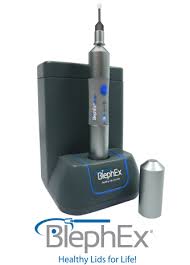
Blepharitis
Blepharitis is a chronic inflammatory disease of the of the eyelid margin. Blepharitis involves the deposition of debris at the base of the eyelashes. Bacteria and a mite called demodex feed on this debris and colonize the lashes and lid margin creating a biofilm and causing inflammation. This condition leads to the release of toxins into the eye. Additionally the bacteria contribute to meibomian gland dysfunction (MGD). MGD contributes to evaporative dye eye syndrome, chalazions and eyelid abscesses.
Meibomian Gland Dysfunction
Demodex Infestation
BlephEx is a device which utilizes a spinning medical grade micro-sponge soaked in different solutions that precisely removes the debris, crust and biofilm along the base of the eyelashes and lid margin. This process is called microblepharoexfoliation. For years clinicians have been instructing patients to treat their blepharitis with lid hygiene. In the past patients were instructed to use a dilute solution of baby shampoo and Q-tips to clean their lids. Blephex brings this process to a new level. After the initial BlephEx treatment patients can maintain their lid hygiene at home with different eyelid pads saturated in antibacterial or anti-demodex solutions. Better yet patients can utilize NuLids a simple device that is easier to use and more convenient than manual lid scrub treatments.
BlephEx can utilize a solution containing tea tree oil which helps to control eyelash infestation by Demodex. Demodicosis is a condition where there is an abnormal infestation of the Demodex mite. Demidicosis has been implicated in meibomian gland disease, chalazion formation, basal cell carcinoma, anterior and posterior blepharitis, conjunctivitis and keratitis.
Tea tree oil stimulates the mite to migrate out of the follicle and is toxic to the mite. For patients with demidicosis we provide the patient with tea tree oil pads to use at home to control the infestation of the Demodex mite. For moderate to severe cases of demodicosis we provide additional in office treatments with high concentrations of tea tree oil applied to the eyelid margin and to the base of the lashes. BlephEx combined with in house tea tree oil treatments and at home maintenance with tea tree pads has been shown to be efficacious in reducing the mite population. I have added a video which I captured from a patient with Demodex blepharitis and viewed under a compound microscope. If you look closely you can see movement of the mite’s “legs”. The configuration of the legs allows the mite to attach to the cylindrical lash. The Demodex mite comes out of the lash follicle at night and feeds on bacteria which compose the biofilm on the lid margin. BlephEx reduces the bacteria available by removing the biofilm. Daily tea tree oil cleanser prevents any of the surviving mites from replicating and laying eggs.
Eyelash Demodex